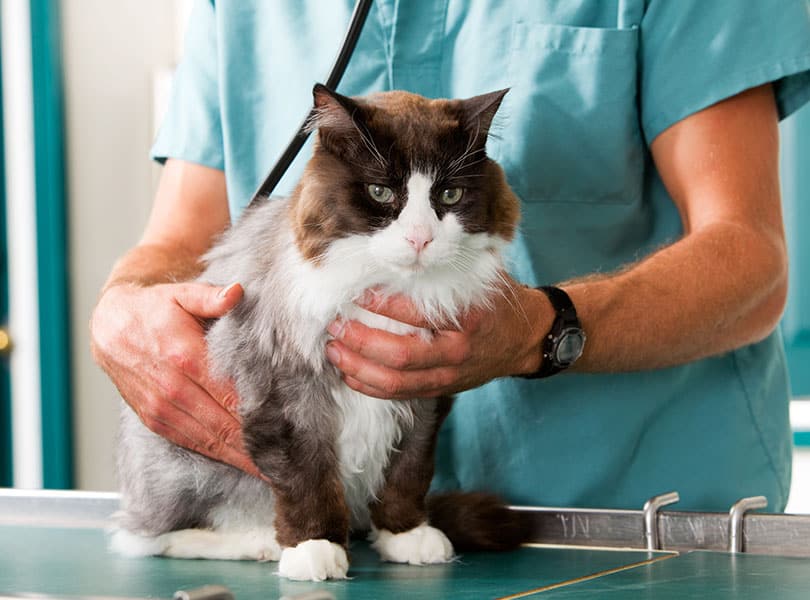What to Expect From a Visit to a Cancer Veterinary Near Me}
Wiki Article
What You Need to Understand About Veterinary Providers: An Introduction of Diagnostic Equipments and Procedures
Vet services play an important duty in maintaining the wellness of family pets. Routine check-ups can expose hidden health and wellness concerns early on. Numerous diagnostic devices and treatments, such as blood tests and imaging strategies, provide necessary insights into a pet's health. Comprehending these approaches is essential for pet dog owners. What details analysis treatments are most typically utilized, and just how can they impact an animal's treatment strategy?Value of Routine Vet Exams
While numerous family pet proprietors might ignore the relevance of normal vet exams, these appointments are necessary for keeping a pet's overall wellness. Routine visits to the veterinarian permit very early discovery of possible wellness concerns prior to they rise right into serious problems. Regular check-ups frequently include vaccinations, which are necessary for stopping infectious illness that might drastically impact a pet's well-being. Additionally, these appointments offer a chance for veterinarians to evaluate the animal's weight, dental health, and overall condition, ensuring that the pet is thriving. During these gos to, family pet proprietors can likewise get useful suggestions on diet regimen, workout, and preventative treatment customized to their details pet dog's needs.Usual Analysis Treatments in Veterinary Medication
In veterinary medicine, exact diagnosis is crucial for efficient treatment. Usual analysis treatments include blood screening methods, advanced imaging modern technologies, and urinalysis, each playing a substantial duty in recognizing wellness issues. Understanding these approaches boosts the capacity to offer proper treatment for animal clients.Blood Testing Techniques
Blood screening strategies offer as necessary analysis devices in veterinary medication, making it possible for vets to examine the health and wellness of animals precisely. These strategies include collecting blood samples to assess various components, such as red and white blood cells, platelets, and biochemical pens. Typical examinations consist of total blood matters (CBC), which evaluate total health and wellness and identify infections, and biochemical panels, which evaluate body organ feature and metabolic condition. Furthermore, serological examinations can identify particular illness via antibody detection. Blood screening is minimally intrusive and provides essential information that aids in identifying conditions, keeping track of health standing, and evaluating actions to therapies. On the whole, these methods play an important duty in guaranteeing perfect treatment for animals and animals alike.Imaging Technologies Used
Analysis imaging modern technologies are necessary devices in veterinary medicine, complementing blood screening strategies by giving visual understandings into a pet's internal frameworks. Typical imaging methods include X-rays, which are helpful for examining bone fractures and finding international items, and ultrasound, which allows for real-time visualization of soft cells and body organs. Magnetic vibration imaging (MRI) supplies detailed photos of complex anatomical areas, particularly in neurological evaluations. Calculated tomography (CT) provides cross-sectional photos, boosting analysis precision for different problems. Each of these innovations aids vets in detecting diseases, planning treatments, and monitoring recovery. By including imaging innovations, veterinary professionals can better assess a pet's health and make informed choices concerning their care.
Urinalysis and Diagnostics
Urinalysis acts as an essential diagnostic tool in vet medicine, supplying useful insights into an animal's general health and wellness and helping in the detection of different conditions. This non-invasive procedure evaluates urine samples to analyze kidney function, hydration standing, and metabolic conditions. Common components examined include certain gravity, pH degrees, glucose, proteins, and the presence of blood or germs. Unusual findings can show concerns such as urinary system infections, diabetic issues mellitus, or kidney condition. To improve diagnostic precision, urinalysis is usually carried out in combination with other examinations, such as blood work and imaging research studies. Early discovery with urinalysis can result in timely interventions, boosting the diagnosis for several vet patients. It is a vital facet of extensive veterinary care.Comprehending Blood Tests and Research Laboratory Evaluation
Understanding blood examinations and lab evaluation is essential in veterinary medicine as it aids in diagnosing numerous health and wellness conditions in pets. Various types of blood examinations offer essential details regarding a pet's inner state, while interpreting lab results calls for careful factor to consider of various factors. This area will explore the types of blood examinations readily available and the importance of their results.Sorts Of Blood Tests
Blood tests play a vital duty in veterinary medicine, supplying essential insights right into a pet's health and wellness standing. Numerous sorts of blood examinations are used, each offering different functions. Complete blood counts (CBC) examine total wellness and detect problems such as anemia or infection. Biochemical accounts examine organ function by measuring enzymes and electrolytes, offering understandings right into metabolic wellness. Serological tests identify specific antibodies or pathogens, assisting in the medical diagnosis of infections or autoimmune illness. Blood inputting guarantees safe transfusions, while coagulation examinations assess the blood's ability to clot, crucial for surgeries. These tests jointly improve diagnosis, treatment preparation, and tracking of a pet's wellness, showing the significance of extensive laboratory evaluation in veterinary treatment.
Translating Laboratory Outcomes
A thorough analysis of laboratory outcomes is essential for accurate diagnosis and treatment in veterinary medication. Translating laboratory results calls for an understanding of regular referral ranges and the importance of discrepancies. Blood examinations can disclose various health indicators, such as body organ function, electrolyte balance, and the existence of infections. Veterinarians should take into consideration the whole clinical photo, consisting of the pet's background, health examination searchings for, and any kind of signs presented. Variations in outcomes may arise from aspects such as age, breed, and underlying health conditions. Lab results ought to not be checked out in isolation yet instead as part of an all-encompassing analysis method. Precise analysis enables customized treatment strategies and far better results for vet clients.Imaging Techniques: X-rays, Ultrasounds, and Beyond
Imaging methods are vital tools in veterinary medicine, providing crucial understandings into the health and wellness and health of animals. Amongst one of the most generally utilized approaches are Ultrasounds and x-rays. X-rays are important for imagining bone structures, assisting veterinarians determine fractures, tumors, or international objects. This approach is non-invasive and fast, making it ideal for immediate situations.Ultrasounds, on the other hand, use sound waves to produce images of soft cells and organs. This method is particularly valuable for analyzing the heart, abdominal area, and reproductive organs, allowing vets to evaluate problems like fluid accumulation or body organ abnormalities.Beyond X-rays and ultrasounds, advanced imaging methods such as computed tomography (CT) and magnetic vibration imaging (MRI) are increasingly made use of in vet practice. These approaches offer in-depth cross-sectional images, enhancing the precision of medical diagnoses and treatment plans. CT Scans For Dogs. On the whole, imaging methods play a crucial role in making sure reliable veterinary careThe Function of Biopsies in Diagnosing Pet Dog Health Issues
Accuracy in identifying find more info wellness concerns in pets typically rests on making use of biopsies, which supply definitive information regarding cells problems. A biopsy involves the removal of a little example of tissue for exam under a microscopic lense, permitting veterinarians to determine numerous problems, consisting of infections, lumps, and inflammatory conditions. This analysis device is essential for distinguishing between benign and malignant growths, leading treatment decisions, and evaluating the intensity of a condition.Biopsies can be done making use of numerous strategies, such as needle aspiration, incisional biopsies, or excisional biopsies, relying on the place and sort of tissue entailed. The choice of method may impact recovery time and the amount of cells gathered. Eventually, the details amassed from a biopsy can bring about targeted treatments, boosting end results for family pets dealing with major health obstacles. Vets highlight the significance of this procedure in attaining precise diagnoses and reliable therapy plans.Advanced Diagnostic Devices: Endoscopy and CT Checks

Advanced analysis tools, such as endoscopy and CT scans, play a crucial function in modern-day veterinary medication, offering non-invasive techniques best site to visualize inner structures and identify numerous conditions in pet dogs. Endoscopy involves making use of a flexible tube furnished with a camera, enabling vets to take a look at the stomach tract and respiratory system straight. This strategy can disclose abnormalities such as tumors, international bodies, or inflammation, allowing targeted treatment plans.CT scans, on the various other hand, use innovative imaging modern technology to create in-depth cross-sectional photos of the body (CT Scans For Dogs). This approach is particularly helpful for examining facility frameworks like the mind, spine, and joints. By offering high-resolution pictures, CT scans help veterinarians in determining problems that might not appear via traditional radiography. Together, these advanced tools enhance diagnostic accuracy, improve treatment outcomes, and ultimately contribute to better overall pet health and wellness administration

Interpreting Examination Results: What Pet Dog Owners Ought To Know
Understanding examination results can be a difficult task for family pet owners, particularly after sophisticated procedures like endoscopy and CT scans have actually been carried out. Analyzing these results needs an understanding of medical terms and a clear understanding of what the searchings for indicate about the family pet's health. Veterinarians often give explanations, yet the intricacy of over at this website the outcomes can still bring about confusion.Pet owners ought to actively take part in conversations with their vets, asking questions to clear up any kind of uncertainties. It is vital to understand normal versus irregular results and the ramifications for the family pet's therapy plan. Additionally, acknowledging that some results might call for more testing or monitoring can help proprietors remain educated about their pet's health and wellness journey. Eventually, a joint strategy in between pet dog proprietors and vet professionals fosters better health results and improves the general care experience for animals.Often Asked Concerns
Exactly how Do I Select the Right Vet Facility for My Pet dog?
Picking the appropriate vet clinic involves investigating regional choices, examining credentials, seeing centers, and assessing team communications (Board Certified Veterinary Cardiologist). Prioritizing recommendations from trusted resources can aid assure the most effective care and environment for a pet dog's wellness requirementsWhat Should I Do if My Animal Refuses to head to the Veterinarian?
When an animal refuses to head to the veterinarian, it's recommended to remain tranquil, use deals with or playthings to entice them, and consider setting up a home go to if anxiety persists. Perseverance and favorable reinforcement are key.Are There Telehealth Options for Vet Solutions?
Telehealth options for veterinary services are significantly readily available, permitting family pet proprietors to speak with vets from another location. These solutions make it possible for conversations concerning wellness worries, suggestions on small disorders, and follow-ups without requiring to check out a center.
Exactly how Typically Should My Animal Have Dental Check-Ups?
The frequency of dental examinations for animals usually depends on their age and breed. Usually, vets suggest annual oral analyses, although some pet dogs may require even more constant check outs to maintain perfect oral wellness.
What Are the Costs Linked With Veterinary Diagnostics?
The costs connected with vet diagnostics can differ widely, normally varying from basic tests like blood work to sophisticated imaging strategies. Aspects influencing costs consist of the facility's area, equipment used, and particular examinations needed for each and every pet. Veterinary services play a crucial function in maintaining the health and wellness of pet dogs. While several pet owners might take too lightly the significance of regular veterinary check-ups, these appointments are important for preserving a pet's total wellness. In addition, these visits supply an opportunity for veterinarians to examine the animal's weight, oral health, and general condition, ensuring that the family pet is growing. Accuracy in detecting health and wellness problems in animals commonly pivots on the use of biopsies, which offer definitive information concerning cells irregularities. Furthermore, recognizing that some results might call for additional testing or surveillance can aid proprietors stay notified regarding their animal's health journey.Report this wiki page